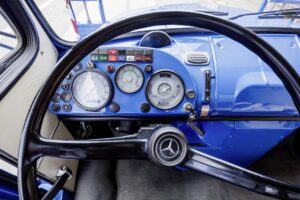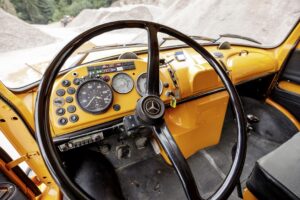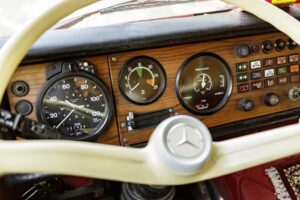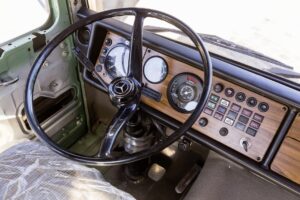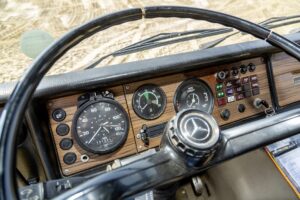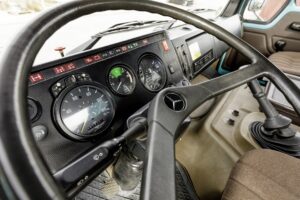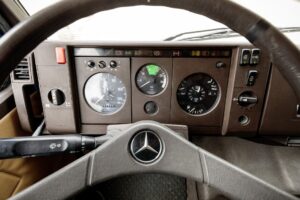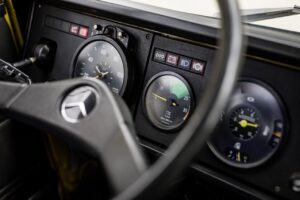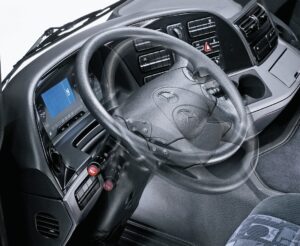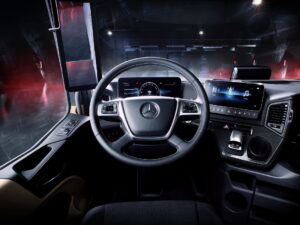My initial thought about this was – erh, no, why should anyone be that interested truck steering wheels?
But looking at the images of the dashboards and steering wheels of Mercedes trucks from over the years does make you start to think back to earlier, more simple times. Try to picture how different these trucks were to drive when compared to the car-like experience of today’s trucks.
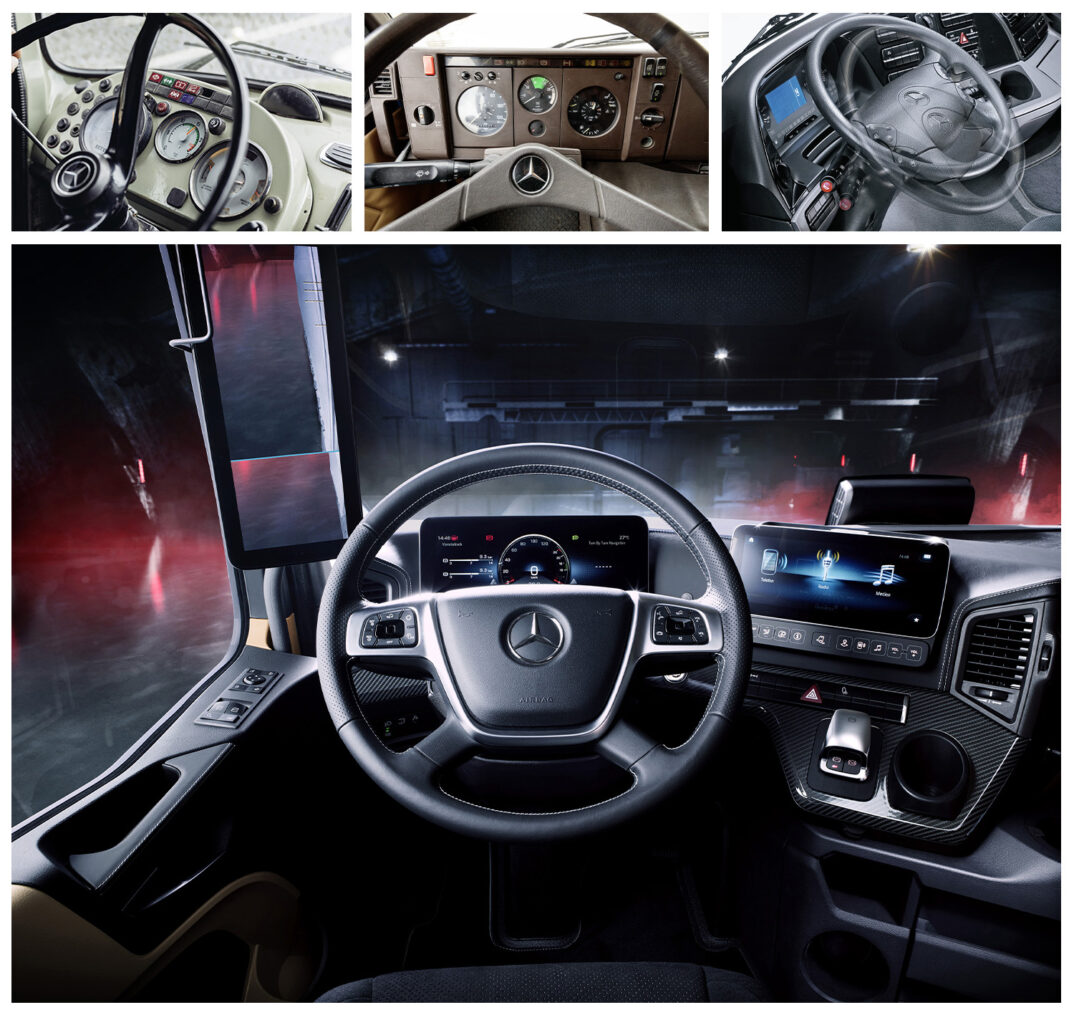
In the top-left image: the cockpit of a Mercedes-Benz 1924 from 1972. From this workplace, the driver monitored the workings of the indestructible OM 355 “Africa engine” under the short bonnet up front.
Next to it, a steering wheel and instrument panel of the so-called Leichte Klasse (light class) or LK cab-over-engine truck models which were characterised by a desire to achieve greater functionality and clarity. This precursor to the Atego was built between 1984 and 1998. You’ll also find a picture of the driver’s workplace in a Mercedes-Benz 1317 tractor unit from 1989. Typical features are the 1980s brown tones, the modest number of switches and the function and warning lamps positioned on the upper edge of the dashboard.
Major modernisation came in the second generation of the Mercedes-Benz Actros which rolled off the production line between 2003 and 2008, shown here on the right. The steering wheel housed a driver’s airbag and the ergonomics of the driver’s workplace were brought up to a totally new level. Seats, steering wheel, switches – numerous elements were already able to be configured individually to the respective driver and field of operation. The dashboard almost wrapped around the driver, such that the incredible number of controls were always within easy reach. Even the display concept had come a long way, with the inclusion of the first digital central display which showed such things as the selected gear and visualisations of any assistance systems which were operating.
An almost fully digital workplace came in 2018 as a world first in a truck. The Multimedia Cockpit was launched in the fifth generation of the Mercedes-Benz Actros, as shown here in the large image. Two high-resolution screens replace the traditional instrument panel. The central display is individually configured by the driver and, using clear graphics, it also displays the operation of the assistance systems such as Active Drive Assist and Predictive Powertrain Control. The secondary display is a touchscreen display and can be operated like a smartphone. Quick access buttons increase the system’s functionality. Plus, the multifunction steering wheel has turned into something of a switchboard. Now also part of the completely re-worked human-machine interface of the new Actros are the two displays of the MirrorCam which are installed in portrait orientation on the A-pillars. They don’t just show the traffic to the rear of the vehicle. Special displays also help when overtaking, whilst moving image views and variable wide-angle formats of the digital rear view mirror can make taking bends and manoeuvring even safer. What’s more, the Multimedia Cockpit now also forms an interface to the outside world: apps help the driver to fulfil their transport tasks. At the same time, the truck is permanently connected with the cloud via the Truck Data Center, which simultaneously also forms the technical basis for connectivity solutions such as Fleetboard and Mercedes-Benz Uptime.

The blue-painted dashboard is a real eye-catcher on this short-bonnet Mercedes-Benz L 2624/6×4 from 1969 which was converted for the heavy haulage. The vehicle also gained a name for itself thanks to the simple yet robust technology on-board, as is reflected in the unassuming instruments of the cockpit. 
The dashboard of the short-bonnet Mercedes-Benz LAK 1624 from 1971 is painted in the vehicle’s body colour, against which the switches and displays of this heavy-duty tipper clearly stand out. 
Cockpit of a Mercedes-Benz 1924 from 1972. From this workplace, the driver monitored the workings of the indestructible OM 355 “Africa engine” under the short bonnet up front. 
Following a diverse range of conversions, the cockpit of this Mercedes-Benz LPK 1626 from 1972 has already been put to use on construction sites, for firefighting and in long-distance transport. Its white steering wheel and copious amount of switches, lights and displays surely have a few stories to tell. 
In the cubic cab of a Mercedes-Benz LPS 2226 6×4 V8 from 1972, a clearly laid out cockpit with a filigree steering wheel awaits its driver. 
A slender steering wheel and sober design characterise the driver’s workplace in the heavy-duty Mercedes-Benz LPK 223 tipper truck which regularly rolled off the Mercedes-Benz production line in Wörth at the beginning of the 1970s. 
In the cabs of the so-called New Generation (NG) models, the use of contemporary, modern plastics was prominent in this clearly laid-out and functional driver’s workplace, as can be seen here in a Mercedes-Benz AK 1936 from 1988. 
Steering wheel and instrument panel of the so-called Leichte Klasse (light class) or LK cab-over-engine truck models. This precursor to the Atego was built between 1984 and 1998. You’ll also find a picture of the driver’s workplace in a Mercedes-Benz 1317 tractor unit from 1989. 
Once a highly modern workplace with ergonomically optimised steering wheel and clear associations of switches and displays can be found in this light-duty Mercedes-Benz LPK 813 tipper from 1985. 
Major modernisation came in the second generation of the Mercedes-Benz Actros which rolled off the production line between 2003 and 2008. The steering wheel housed a driver’s airbag and the ergonomics of the driver’s workplace were brought up to a totally new level. Seats, steering wheel, switches – numerous elements were already able to be configured individually to the respective driver and field of operation. 
The Multimedia Cockpit was launched in the fifth generation of the Mercedes-Benz Actros. Two high-resolution screens replace the traditional instrument panel.

